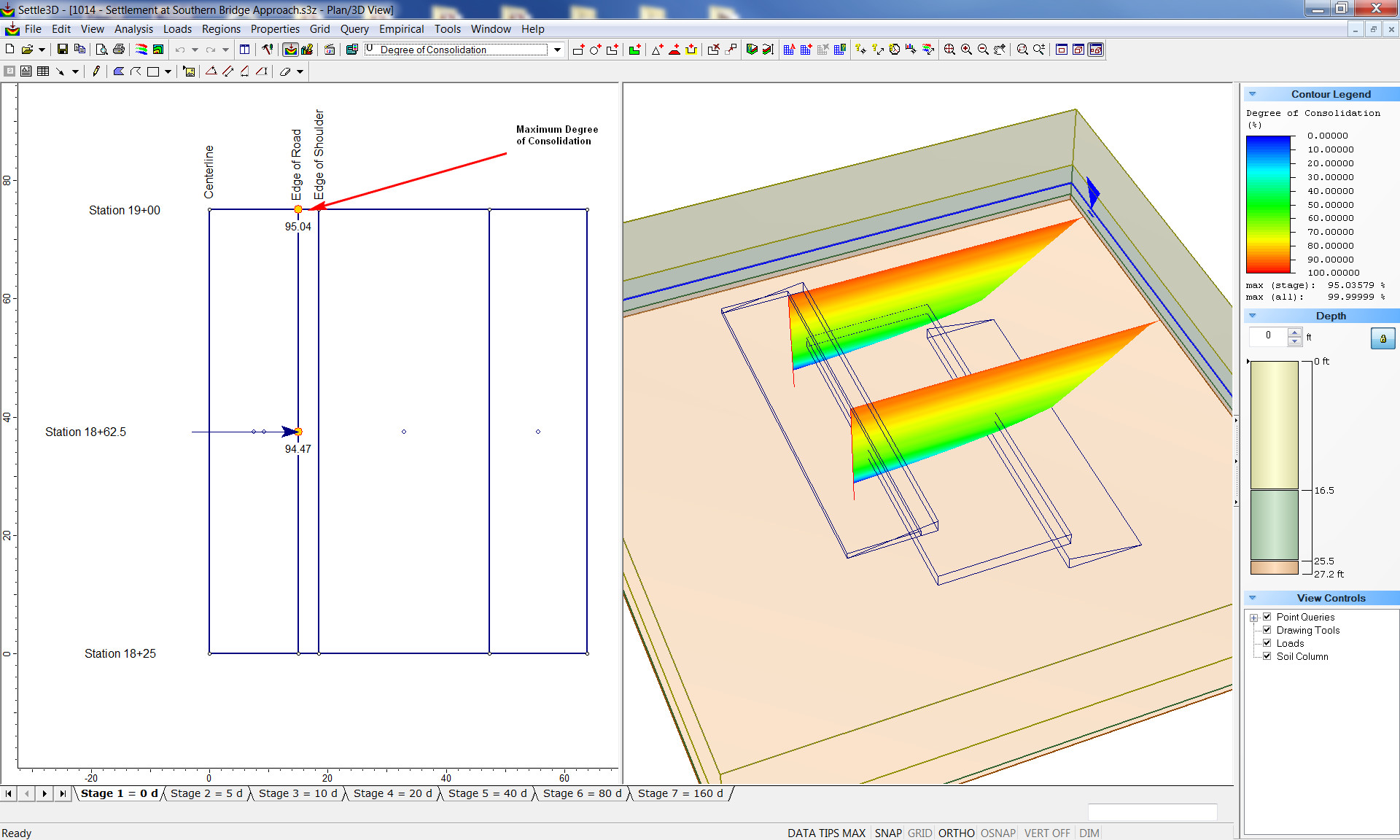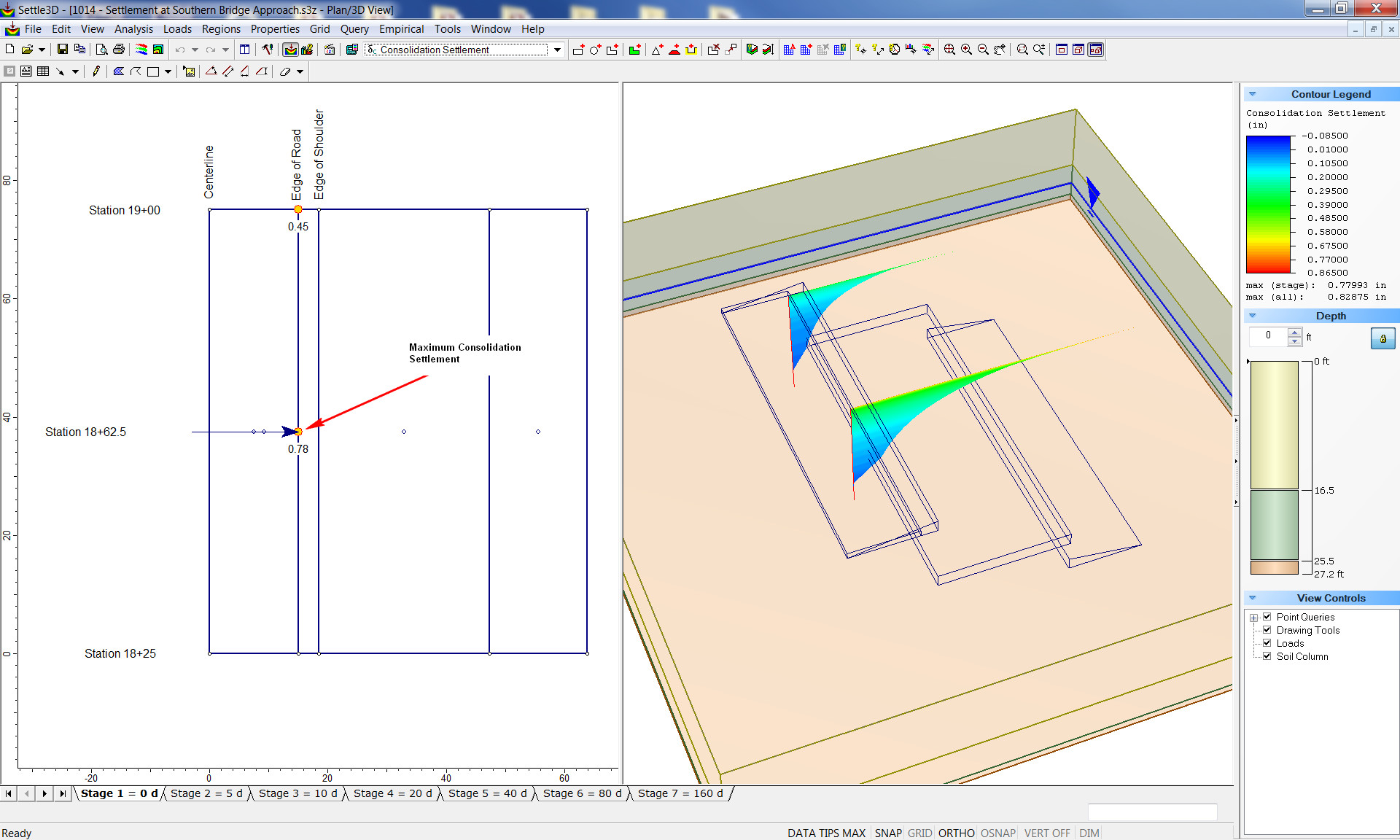Theory
Here is a collection of common Settle3 tech support theory questions.
Consolidation
How is secondary consolidation considered in terms of setting up stages?
The secondary consolidation (creep) calculations start at the end of primary consolidation. A primary consolidation of 100% only occurs after infinite time, and for this reason a default value of 95% primary consolidation is used as the starting point for secondary consolidation. This means that secondary settlement will only be calculated in the current stage if the degree of consolidation at the previous stage reached the specified value (e.g. 95%).
In determining how to set up your model, first understand that a stage represents a specific time, not a time interval, when doing time-dependent consolidation analyses. So the settlement occurs between stages. If you apply a load in Stage 1, primary consolidation will occur between Stage 1 and Stage 2. Since the earliest check for secondary consolidation is performed after some consolidation has occurred, this must be Stage 2. So the earliest secondary consolidation can start is Stage 2. Therefore there is no way to get secondary consolidation to occur between Stage 1 and Stage 2. Thus the reason why when doing an analysis with secondary consolidation it is important to use many stages during the primary consolidation phase in order to properly determine the time at which secondary consolidation kicks in.
You can also use the Time Point option to determine precisely when secondary consolidation will start and add a stage at that time.
What is the difference between Degree of Consolidation and Average Degree of Consolidation?
Settle3 calculates both the Degree of Consolidation and the Average Degree of Consolidation.
The Degree of Consolidation is calculated using the equation below, which can also be found in the Theory Manual. Consolidation settlements are used in the calculation.

The Average Degree of Consolidation is calculated as shown below, where the average consolidation is the average over the depth of the soil layer.

See the Theory Manual for a more complete description.
How does Settle3 calculate Degree of Consolidation?
Degree of consolidation, like consolidation settlement, is computed at numerous locations along the queries. The maximum degree of consolidation reported in the Report Generator is the maximum of all these individual values computed along the queries. Since the location of the maximum degree of consolidation may not be the same as the location of maximum consolidation, you cannot use the maximum consolidation settlement in the Report Generator to compute the maximum degree of consolidation in the Report Generator. For example, in Stage 1, the location of the maximum degree of consolidation is different than the location of the maximum consolidation settlement in the images below. Basically, you have to use the settlements from the same location to compute degree of consolidation.

Location of maximum degree of consolidation

Location of maximum consolidation settlement
When should the "Generate excess pore pressures above water table" option be selected?
Basically, the "generate excess pore pressures above water table" option allows you to specify whether you want immediate or long-term consolidation settlement to be calculated above the water table. In most cases, turning this option on, and considering the consolidation above the water table as part of the total consolidation settlement, is appropriate.
When the option is not selected, when there is no excess pore water pressure generated above the water table, the layers above the water table will have an immediate consolidation settlement:

This option has the most influence in cases where the water table is low in the clay layer. Further explanation can be found in the Groundwater topic.
Loading
How is an excavation calculated in Settle3?
In Settle3, an excavation is considered to be a negative load.
If you were to model only the excavation, the loading stress would be -γd where d is the depth of the excavation and γ is the unit weight of the soil. The loading stress when modeling only the excavation is the negative of the overburden stress. The total stress would then be 0 kPa (assuming metric units), since the overburden stress is always added to the loading stress to get the total stress.
If you specify a load of, say, 100 kPa at the bottom of the excavation, the calculated loading stress will be 100 kPa + excavation load = 100 + (-γd). The overburden stress is then added on to make the total stress equal to 100 kPa. Basically, if you want to model a certain loading stress at the bottom of an excavation, you need to specify a stress equal to the stress from the external load as well as the stress from the overburden.
Can Settle3 account for interaction between rigid loads?
Settle3 does not consider the interaction between more than one rigid load, which means that the results will be unreliable for rigid loads which are close to each other. Settle3 also does not consider the interaction between rigid and flexible loads. Only interaction between flexible and flexible loads is considered. Note that excavations are considered to be flexible loads.
What are the limitations of modelling time-dependent consolidation under a rigid load?
There are two complexities with the calculation of time-based consolidation settlement for rigid loads in Settle3. First, Settle3 implements an uncoupled solution for the load and excess pore water pressure. The rigid load creates very high load concentration at the boundary of the load which accelerates the process of pore water dissipation but will not trigger any load redistribution. Second, Settle3 uses a 1D consolidation formulation. This means that there is no redistribution of the excess pore water pressure in the x-direction. Both these issues will create problems for time-dependent consolidation analyses.
Note that Settle3 solves the rigid foundation as a load with full contact to the soil underneath. The solution for semi-rigid with no tension is more complicated and an alternate numerical technique such as the finite element method may be more suitable for problems that require that type of analysis.
When is the "use average properties to compute layered stresses" option in the Advanced tab of the Project Settings applicable?
This option is valid for the following cases:
- Multiple Layer stress computation method is selected
- Westergaard stress computation method is selected
- Boussinesq stress computation method is selected AND Use mean 3D stress option is selected
Advanced Analysis Options
How is buoyancy considered in Settle3?
In Settle3, as a point moves downwards, it descends further below the water table. This causes a pore pressure increase at the point and therefore an effective stress decrease. In addition, if soil that was originally above the water table settles below the water table, then the soil become saturated and its unit weight may increase. This causes an effective stress increase at all points below the submerged soil.
By default, we ignore this effect in the settlement calculations, as it is usually quite small. In cases where the buoyancy effect may be significant, it can be included by selecting the Include Buoyancy Effect checkbox in the Advanced Settings dialog.
There are several assumptions associated with this option, and these are outlined in the Settle3 Theory Manual, available in the Online Help.
Note that we do not recommend applying buoyancy as a default setting (it is off by default). To determine if this setting is appropriate it is best to compare the Settle3 results with field measurements.
What is the settlement cutoff option?
This option allows you to specify the minimum amount of loading stress required to induce settlement. If the loading stress at depth drops below the specified fraction of the in-situ effective stress, then no settlement will occur below that point.